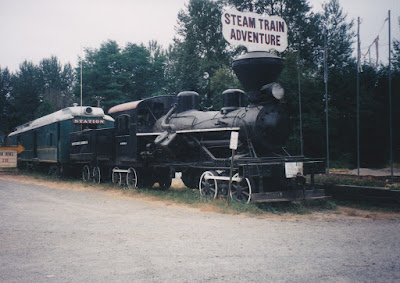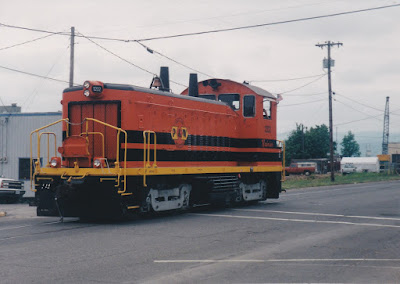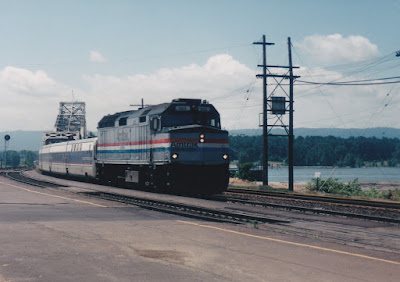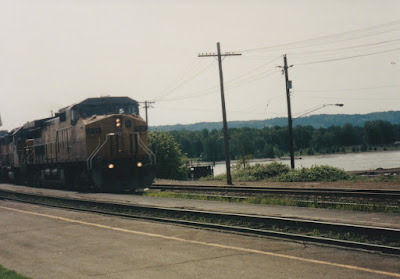On April 26, 1998, my dad and I went railfanning with his friend Fred Anderson. We started out at the Amtrak depot in Vancouver, Washington. We soon saw some interesting light motive power pass through.
LRCX SF30C #9529 was originally a 3,600-horsepower U36C that was built by General Electric in June 1972 as Atchison, Topeka & Santa Fe #8702. In February 1986 it was rebuilt by the Santa Fe's shops in Cleburne, Texas as a 3,000-horsepower SF30C and renumbered to #9529. It was sold to Livingston Rebuild Center Inc. on August 6, 1997, becoming LRCX #9529.
On the other leg of the wye came a northbound Union Pacific freight train. Union Pacific #9730 is a 4,380-horsepower Dash 9-44CW that was built by General Electric in August 1994.
Another light power move soon followed. Burlington Northern GP39E #2902 was originally built by the Electro-Motive Division of General Motors in April 1965 as Great Northern GP35 #3039. It was originally powered by a 2,500-horsepower turbocharged 567 engine. After the Great Northern was merged into Burlington Northern on March 2, 1970, it became Burlington Northern #2522. In June 1990 it was rebuilt by the Electro-Motive Division of General Motors as 2,300-horsepower GP39E Burlington Northern #2902.
Burlington Northern #2279 is a 2,000-horsepower GP38-2 that was originally built by the Electro-Motive Division of General Motors in July 1973 as St. Louis-San Francisco (SLSF, also known as the Frisco) #424. The Frisco was merged into the Burlington Northern in 1980, and this locomotive was renumbered as Burlington Northern #2279. It still has a notch in its nose where the Frisco's oscillating warning light was mounted.

We left Vancouver and went down the Washington side of the Columbia River Gorge to Skamania, Washington. Leading a westbound freight train, Montana Rail Link #325 was originally a 3,600-horsepower SD45 that was built by the Electro-Motive Division of General Motors in December 1968 as St. Louis Southwestern (SSW, also known as the Cotton Belt) #9064. The Cotton Belt was a Subsidiary of the Southern Pacific, and on September 23, 1985, this locomotive was upgraded at Southern Pacific's Sacramento Shops to an SD45R and became Southern Pacific #7554. Following the merger of the Southern Pacific into the Union Pacific, in January 1997 this locomotive was sold via Coast Engine & Equipment Company of Tacoma, Washington, to Montana Rail Link, where it was classified as an SD45-2 and became #325.
The second locomotive in this consist was Burlington Northern Santa Fe #1004, a 4,400-horsepower Dash 9-44CW that was built by General Electric in October 1996.
The last unit was EMDX #6043, a 3,000-horsepower SD40-2 that was originally built by the Electro-Motive Division of General Motors in December 1973 as Chicago, Rock Island & Pacific #4793 under a lease agreement. The Rock Island shut down on March 31, 1980, and in June 1980, the locomotive's lease was by the Illinois Central Gulf, and it become ICG #6043. Following the end of the lease period, it was returned to EMD, equipped with dynamic brakes (which it never had before) and added to the Electro-Motive Leasing fleet, becoming EMDX #6043 in January 1989.

Next came an eastbound freight train led by LMX #8547, a 3,900-horsepower B39-8E that was built by General Electric in October 1987. This is one of a group of 100 identical locomotives that were built for lease to Burlington Northern under a "power by the hour" arrangement, in which Burlington Northern payed only for the kilowatt-hours the locomotives produce, plus a base monthly charge. Under the agreement, General Electric handled the maintenance of the locomotives in Lincoln, Nebraska, using Burlington Northern union personnel under GE supervision. This train consisted of empty intermodal well cars, some of which had just come from Gunderson in Portland, Oregon, and were so fresh from the factory that we could smell the paint as they passed by.

We returned to Vancouver, where we saw Atchison, Topeka & Santa Fe #136, a 3,800-horsepower GP60M that was built by the General Motors Locomotive Group in London, Ontario, in July 1990. Santa Fe's "Super Fleet" locomotives were still rare in the Pacific Northwest, and the GP60Ms were especially rare.
A southbound intermodal train arrived, led by Union Pacific #9222, a 4,000-horsepower Dash 8-40C that was built by General Electric in September 1988.
The second unit of this train was Denver & Rio Grande Western #5358, a 3,000-horsepower SD40T-2 that was built by the Electro-Motive Division of General Motors in July 1975.
This train came to a stop in front of the Vancouver depot, allowing for more opportunities for photographs. Rio Grande tunnel motors still weren't very common in the Pacific Northwest.
Union Pacific #9222 still looked pretty sharp considering it was just a few months from its 10th birthday.
A northbound freight train arrived, led by Union Pacific #8104, a 4,300-horsepower SD9043AC that was built by the General Motors Locomotive Group in London, Ontario, in March 1997.
The second unit was Union Pacific #8103, another 4,300-horsepower SD9043AC that was built by the General Motors Locomotive Group in London, Ontario, in March 1997.
This train also came to a stop in front of the Vancouver depot. These were the first SD90s I had seen, so I took the opportunity to take several photographs of these sequentially numbered twins, despite the fading daylight.
The SD90MAC was intended to be powered by a 6,000-horsepower 16-cylinder 265H four-stroke diesel engine, but there were problems in this new engine's development. Union Pacific purchased SD90MACs with the proven 4,300-horsepower 16-cylinder 710G3C two-stroke diesel engine, intending to replace the 710G3C engines with the 265H when the new engines were ready.
Union Pacific designated these locomotives SD9043AC, while the EMD designation was simply SD90MAC. The SD90s that were built with the 265H engine were called SD90MAC-H by EMD, but Union Pacific designated them SD90AC. Ultimately, the 265H engine would be deemed a failure, and the SD9043ACs would keep their 710G3C engines and remain in service longer then their more powerful 265H-powered sisters.











































